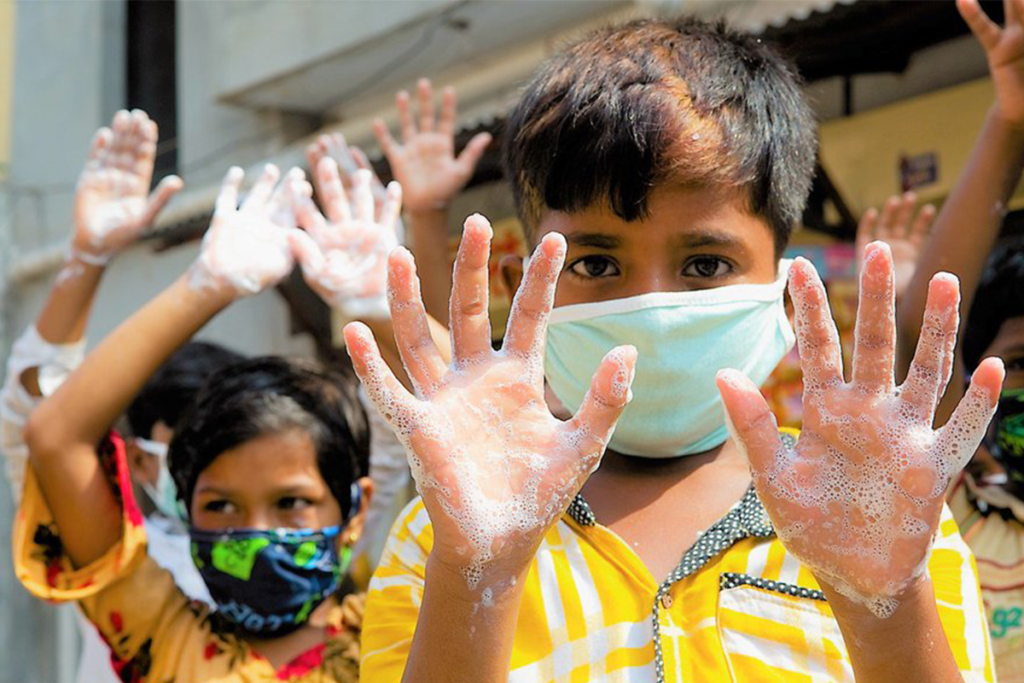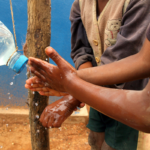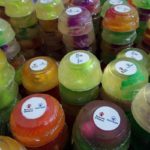Handwashing has always been important for young people to prevent the spread of infections. The COVID-19 pandemic provides an important reminder of just how critical water, sanitation and hygiene (WASH) access and practice are to protecting young people and their families. Understanding disparities in WASH access and practice can help marginalized populations become less vulnerable. The Global Handwashing Partnership’s annual handwashing research summary compiles new research to help increase awareness of and provide solutions for such inequities. In helping to compile and analyze research for this year’s summary, I was able to connect my broader interest in child health to the impact of WASH among young people. Several new publications focus on the WASH practices of young people during the pandemic and I highlight three of those articles in this post.
Are primary school students washing their hands and wearing masks?
Primary school students are often exposed to infections at places like playgrounds and school gyms. Schools must assess the compliance of preventive behaviors, such as handwashing, among students to reduce this exposure and protect against diseases like COVID-19.
A study by Xuyu Chen and colleagues (2020) conducted in Wuhan, China uses self-reported surveys to collect data on handwashing and mask-wearing behavior among students then uses a logistical regression to identify risk factors influencing those protective behaviors. The authors find that only 42% of students show good handwashing behavior and 51% wear their masks. They also find that factors like gender, parent-education level, and parental occupation influence these behaviors.
Chen et al. report that parent-education level is correlated to increased perceived susceptibility and severity of COVID-19 infection, both of which are behavioral determinants for handwashing. Specifically, the authors note that mothers with increased COVID-19 awareness are able to teach their children more about safety education and preventive hygiene measures. These findings highlight the intersectionality of health care, exemplifying how care can benefit from indirect factors such as increasing accessibility and affordability of education. Interventions aimed at improving education can better equip parents to teach their children better hygiene behaviors, as well as prepare children from a younger age to understand the importance of infectious preventive measures. Increasing educational attainment also increases average income, reduces poverty and improves the overall health of the public.
How does gender impact personal hygiene behaviors?
A study by Dominika Guzek and colleagues (2020) analyzes gender-dependent hand hygiene and personal protective behaviors (like wearing a mask and staying at home) among secondary school-age students in Poland. The authors use an electronic questionnaire to gather information from students on their knowledge and beliefs about protective behaviors and their actual behaviors during the pandemic. Guzek et al. find that female students show higher levels of knowledge about protective behaviors and also exhibit better behaviors. For example, female students show a higher frequency of handwashing. Higher adherence rates among females may be explained by their decreased inclination to engage in risky behaviors. However, there is no concrete explanation yet.
Devina Halim and colleagues (2020) also find a better understanding of COVID-19 among young females in Indonesia. The authors use an online, open-ended questionnaire to collect data from adolescents (ages 10 to 25) about their COVID-19 knowledge, e.g., risk factors, symptoms, and how to prevent and control the pandemic. Halim et al. find young people understand what the symptoms of COVID-19 are but not about behaviors to prevent its spread. Less than half know about physical distancing and even fewer mention handwashing as a protective behavior. The authors associate better understanding with two factors: gender and income. It is unknown though how income impacts the strength of gender as a variable.
We need additional research to determine the exact explanation for why the female gender is associated with higher rates of compliance with personal preventive measures. The data show females have a higher level of knowledge about COVID-19 but if all students receive the same education from the same school it begs the question of what factors are causing the discrepancy. Additionally, because these studies use self-reported surveys among adolescents, we run into the issue of whether these findings are accurate.
While these three studies present novel findings regarding gender, it is important to evaluate the generalizability of the studies. Current research appears to be strictly binary, excluding non-binary and transgender young people. Without research including non-binary and transgender populations, it is impossible to assess if increased adherence rates are also consistent among female transgender youth. The inclusion of non-binary and transgender young people in research will increase the generalizability of the findings as well as decrease stigma.
What’s the missing piece?
While research shows gender and other associated factors like parent-education levels may be protective factors, I’m still left wondering what exactly causes young people to not take appropriate personal protective measures like handwashing.
Halim et al. also confirm that young people’s main source of information is from social media rather than official COVID-19 government sources. If young people are adamant about getting their news from social media, the government and health care organizations must then adapt to informing their targeted population in a manner that is most appealing to the population of interest.
For example, governments could create an app aimed at informing young people about the most important health care updates regarding COVID-19 as well as other future health issues. Another example could be a collaboration with social media companies such as Twitter, where Twitter can push mobile phone notifications to their users with short reminders and updates about the most important personal protective behaviors. These examples of collaboration could offer a relatable outlet to young people and may be the solution for closing the gap of misinformation.
As an aspiring pediatrician, I know that sustainable WASH practices among young people are crucial not only in light of the COVID-19 pandemic but also to prevent other infections throughout childhood. Interventions should be tailored to target populations, such as young people, in order to increase effectiveness. Research must be analyzed with the intent to introduce new interventions that produce sustainable, improved hand hygiene among young people. By increasing the personal protective behaviors of young people, we will decrease the spread of COVID-19 and simultaneously improve the overall health of everyone.
Photo credit: Kiron/UNICEF Bangladesh



